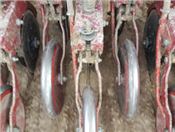Before Heading To The Field, Take The Time To Make Sure Your Equipment’s Up To The Task At Hand

Drills should be cleaned from mud to prevent rust and ensure proper function.
Photo courtesy of Dirk Philipp
LITTLE ROCK, ARK.
As winter begins its bumpy transition to spring throughout Arkansas, many producers are readying to prep their fields for planting season.
Before the hour is at hand, however, be sure and take the time to make sure your equipment is up to snuff.
Dirk Philipp, Associate Professor of Animal Science for the University of Arkansas System Division of Agriculture, says that among all planting equipment used – especially for grassland and pasture managers – the drill is usually the most important.
“It’s importance really can’t be overstated,” Philipp said. "Planting new forages is a long-term investment that doesn’t come cheap. Correct seeding rates, planting evenly at the right depth, and achieving uniform forage stands are important for long-term forage persistence.”
No-till drills are a common tool in grassland agriculture. While robust, they need to be checked before the season. Philipp recommends following these basic maintenance tips to avoid becoming stranded in the field:
Check the major components of the drill for proper working and cleanliness
Seed boxes need to be clean and empty year-round, otherwise moisture and rust accumulate, and seeds may even sprout in them
Tubes and hoses are the prime location for spider webs. Use a long rod and rag to pull through all the tubes to remove all blockages
Planting wheels may get wobbly over time, so bearings may have to be replaced. The wheels need to be able to spin freely to be effective. Remove the dirt and mud from above the wheels to not impede the seed flowing during planting.
When it comes to bearings and other moving parts, remember that there are several points on each drill that can be maintained with grease. Check all of them before the season. Some drills feature hydraulic setups, so check the hoses for leakage.
Try the drill out before calibrating and planting with the real seeds. It’s a good idea to put some leftover seed into the boxes and drive for several hundred feet to check on proper and even seed delivery. ∆